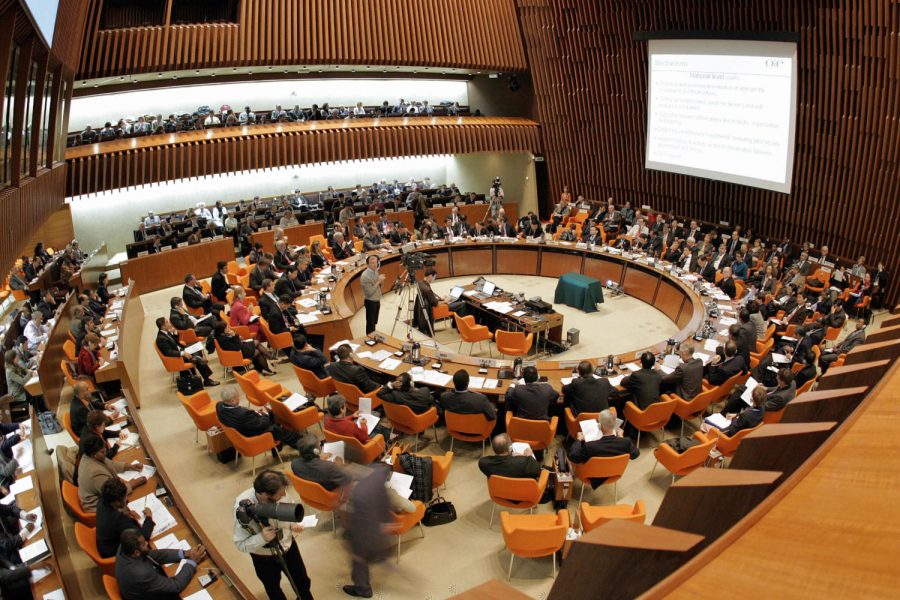[bt_bb_section layout=”boxed_1200″ lazy_load=”yes” show_video_on_mobile=”” show_sticky=”show-top” show_previous_posts=”show” force_posts_show=”default” order_by=”default” border=”default” top_spacing=”normal” bottom_spacing=”” full_screen=”” vertical_align=”top” color_scheme=”” background_color=”” background_image=”” background_overlay=”” parallax=”” parallax_offset=”” background_video_yt=”” yt_video_settings=”” background_video_mp4=”” background_video_ogg=”” background_video_webm=”” responsive=”” category_filter=”” post_format_filter=”” taxonomy_filter=”” author_filter=”” date_filter=”” publish_datetime=”” expiry_datetime=”” animation=”no_animation” el_id=”” el_class=”” el_style=””][bt_bb_row][bt_bb_column order=”0″ lazy_load=”yes” width=”1/1″ width_lg=”1/1″ width_md=”1/1″ width_sm=”1/1″ width_xs=”1/1″][bt_bb_text]
On the 15th of November 2021, the World Health Organization (WHO) held its annual Evidence to Policy (E2P) summit. During which, they discussed both new and old research, and began policy discussions. The outcome of these discussions will be released in the 2022 government policy recommendations sometime in late December. This E2P summit, four main issues were brought up: school meals, tobacco use, barriers to insulin release, and the ongoing effects of the Sars-CoV-19 pandemic (commonly referred to as COVID-19.)
[/bt_bb_text][bt_bb_separator top_spacing=”normal” bottom_spacing=”normal” border_style=”solid” border_width=”5px” responsive=”” publish_datetime=”” expiry_datetime=”” animation=”no_animation” el_id=”” el_class=”” el_style=””][/bt_bb_separator][/bt_bb_column][/bt_bb_row][/bt_bb_section][bt_bb_section layout=”boxed_1200″ lazy_load=”yes” show_video_on_mobile=”” show_sticky=”show-top” show_previous_posts=”show” force_posts_show=”default” order_by=”default” border=”default”][bt_bb_row][bt_bb_column order=”0″ lazy_load=”yes” width=”1/1″ width_lg=”1/1″ width_md=”1/1″ width_sm=”1/1″ width_xs=”1/1″][bt_bb_headline supertitle_position=”outside” font_subset=”latin,latin-ext” superheadline=”” headline=”Implementing SMART Meals in Schools” subheadline=”” html_tag=”h3″ align=”center%$%%$%%$%%$%” dash=”none” color_scheme=”” color=”” font=”inherit” font_size=”” font_weight=”” url=”” target=”_self” responsive=”” publish_datetime=”” expiry_datetime=”” animation=”no_animation” el_id=”” el_class=”” el_style=”” size=”inherit”][/bt_bb_headline][bt_bb_separator top_spacing=”small” bottom_spacing=”small” border_style=”none” border_width=”” responsive=”” publish_datetime=”” expiry_datetime=”” animation=”no_animation” el_id=”” el_class=”” el_style=””][/bt_bb_separator][bt_bb_text]
The Sars-CoV-19 pandemic caused significant disruptions to schools all across the nation. With many schools switching to either online or hybrid learning, areas such as counseling and school meals were all but thrown out the window with many students simply not receiving the services they needed. As part of the E2P summit, the WHO took a closer look at school lunches — both at their distribution and contents.
In a joint declaration, five agencies committed to assisting the School Meals Coalition. The Coalition’s goals are two fold:
- Improve the distribution of school meals to students.
- Assist in the implementation of “SMART” school meal programs which combine food with health and nutrition education.
The Coalition’s mission statement, as said by Dr. Tedros, is to “help to combat child poverty, hunger, and malnutrition in all its forms.” As well as to “attract children to school and support children’s learning, and long-term health and well-being.”
The five UN agencies included in this coalition are: The Food and Agriculture Agency, The UN Educational Administration, The Scientific and Cultural Agency, UNICEF, the UN World Food Programme, and the WHO. These five agencies will be collaborating to write a section in the policy recommendations coming out in mid-December.
[/bt_bb_text][bt_bb_separator top_spacing=”normal” bottom_spacing=”normal” border_style=”none” border_width=”” responsive=”” publish_datetime=”” expiry_datetime=”” animation=”no_animation” el_id=”” el_class=”” el_style=””][/bt_bb_separator][/bt_bb_column][/bt_bb_row][/bt_bb_section][bt_bb_section layout=”boxed_1200″ lazy_load=”yes” show_video_on_mobile=”” show_sticky=”show-top” show_previous_posts=”show” force_posts_show=”default” order_by=”default” border=”default”][bt_bb_row][bt_bb_column order=”0″ lazy_load=”yes” width=”1/1″ width_lg=”1/1″ width_md=”1/1″ width_sm=”1/1″ width_xs=”1/1″][bt_bb_headline supertitle_position=”outside” font_subset=”latin,latin-ext” superheadline=”” headline=”Tobacco Use is Falling: WHO Urges Countries to Invest More in Helping People Quit Tobacco” subheadline=”” html_tag=”h2″ align=”center%$%%$%%$%%$%” dash=”none” color_scheme=”” color=”” font=”inherit” font_size=”” font_weight=”” url=”” target=”_self” responsive=”” publish_datetime=”” expiry_datetime=”” animation=”no_animation” el_id=”” el_class=”” el_style=”” size=”inherit”][/bt_bb_headline][bt_bb_row_inner][bt_bb_column_inner width=”1/2″ width_lg=”1/2″ width_md=”1/2″ width_sm=”1/2″ width_xs=”1/1″ order=”0″ lazy_load=”yes”][bt_bb_image lazy_load=”yes” image=”2836″ size=”full” image_height=”” shape=”square” align=”inherit%$%%$%%$%%$%” caption=”” url=”” target=”_self” hover_style=”simple” content_display=”always” content_background_color=”” content_background_opacity=”” content_align=”middle” responsive=”” publish_datetime=”” expiry_datetime=”” animation=”no_animation” el_id=”” el_class=”” el_style=””][/bt_bb_image][/bt_bb_column_inner][bt_bb_column_inner width=”1/2″ width_lg=”1/2″ width_md=”1/2″ width_sm=”1/2″ width_xs=”1/1″ order=”0″ lazy_load=”yes”][bt_bb_text]
Tobacco use worldwide has been falling, from 1.32 billion in 2015 to 1.30 billion today. That’s a drop of 20 million users worldwide. Despite this, more and more young people are still starting to smoke. The WHO discussed this worrying trend and said that although we are seeing great progress in developing countries, young people in developed countries are bringing vaping back up to it’s pre 2015 levels.
[/bt_bb_text][/bt_bb_column_inner][/bt_bb_row_inner][bt_bb_text]
Dr. Rudeiger Krech, Director of WHO Department of Health Promotion, said that “this success is fragile. We still need to push ahead.”
The WHO says their policy recommendations for 2022 will focus on local community assistance and more on the younger generations in developed countries.
[/bt_bb_text][bt_bb_separator top_spacing=”normal” bottom_spacing=”normal” border_style=”none” border_width=”” responsive=”” publish_datetime=”” expiry_datetime=”” animation=”no_animation” el_id=”” el_class=”” el_style=””][/bt_bb_separator][/bt_bb_column][/bt_bb_row][/bt_bb_section][bt_bb_section layout=”boxed_1200″ lazy_load=”yes” show_video_on_mobile=”” show_sticky=”show-top” show_previous_posts=”show” force_posts_show=”default” order_by=”default” border=”default”][bt_bb_row][bt_bb_column order=”0″ lazy_load=”yes” width=”1/1″ width_lg=”1/1″ width_md=”1/1″ width_sm=”1/1″ width_xs=”1/1″][bt_bb_headline supertitle_position=”outside” font_subset=”latin,latin-ext” superheadline=”” headline=”The Barriers to Insulin Release” subheadline=”” html_tag=”h2″ align=”center%$%%$%%$%%$%” dash=”none” color_scheme=”” color=”” font=”inherit” font_size=”” font_weight=”” url=”” target=”_self” responsive=”” publish_datetime=”” expiry_datetime=”” animation=”no_animation” el_id=”” el_class=”” el_style=”” size=”inherit”][/bt_bb_headline][bt_bb_text]
Even 100 years after it’s discovery, insulin is still out of reach for many Americans. Only 50% of those who need insulin are receiving it on a regular basis. This is because even though the patent was sold for only one dollar in 1923, there are still only three companies who make more than 90% of the global insulin supply. These are Novo Nordisk, Sanofi, and Eli Lilly. They provide insulin for the over 7.2 million Americans living with diabetes today.
Insulin is what economists call, infinite need. This means that the price can never get higher than the need and the need will never dry up. Because of this infinite need and the lack of competition, the companies can charge whatever they want for insulin — and they charge exorbitant prices.
These high prices result in over 80% of those hospitalized for type 2 diabetes being in the lower or lower middle classes. Although we always knew that insulin was priced out of reach for many Americans, we never had the hard numbers until the pandemic pushed both production and hospitals to a breaking point and people started to look for ways to reduce hospitalizations.
Dr. Tedros says the number one way to lower diabetes hospitalizations is to increase the production of insulin and limit the price, even subsidizing it if necessary. While many American policy makers have voiced their agreement, they have been reluctant to regulate the price of insulin.
[/bt_bb_text][bt_bb_separator top_spacing=”normal” bottom_spacing=”normal” border_style=”none” border_width=”” responsive=”” publish_datetime=”” expiry_datetime=”” animation=”no_animation” el_id=”” el_class=”” el_style=””][/bt_bb_separator][/bt_bb_column][/bt_bb_row][/bt_bb_section][bt_bb_section layout=”boxed_1200″ lazy_load=”yes” show_video_on_mobile=”” show_sticky=”show-top” show_previous_posts=”show” force_posts_show=”default” order_by=”default” border=”default”][bt_bb_row][bt_bb_column order=”0″ lazy_load=”yes” width=”1/1″ width_lg=”1/1″ width_md=”1/1″ width_sm=”1/1″ width_xs=”1/1″][bt_bb_headline supertitle_position=”outside” font_subset=”latin,latin-ext” superheadline=”” headline=”Global Covid-19 Pandemic Ongoing” subheadline=”” html_tag=”h1″ align=”inherit%$%%$%%$%%$%” dash=”none” color_scheme=”” color=”” font=”inherit” font_size=”” font_weight=”” url=”” target=”_self” responsive=”” publish_datetime=”” expiry_datetime=”” animation=”no_animation” el_id=”” el_class=”” el_style=”” size=”inherit”][/bt_bb_headline][bt_bb_text]
While people’s response to Sars-CoV-19, better known as COVID-19, has been decreasing, the actual number of cases has still been climbing. In the early days of the COVID-19 vaccine, there was a very limited supply. However, that low supply quickly turned into low demand. Today in Missoula, only 55.57 percent of the population has been fully vaccinated.
[/bt_bb_text][bt_bb_row_inner][bt_bb_column_inner width=”1/2″ width_lg=”1/2″ width_md=”1/2″ width_sm=”1/2″ width_xs=”1/1″ order=”0″ lazy_load=”yes”][bt_bb_text responsive=”” publish_datetime=”” expiry_datetime=”” animation=”no_animation” el_id=”” el_class=”” el_style=””]
Missoula is still classified as a high transmission zone by the CDC and our case numbers are rising. While hospitals, like Community Medical Center, are struggling to keep up with the number of COVID-19 patients, our lax attitude towards mitigation is worrying. I have included a local community tracker from the CDC to view transmission rates in your area. This information changes day to day.
[/bt_bb_text][/bt_bb_column_inner][bt_bb_column_inner width=”1/2″ width_lg=”1/2″ width_md=”1/2″ width_sm=”1/2″ width_xs=”1/1″ order=”0″ lazy_load=”yes”][bt_bb_raw_content raw_content=”CjxkaXYgZGF0YS1jZGMtd2lkZ2V0PSJDT1ZJRENvdW50eUNoZWNrIiA+PC9kaXY+IAogPHNjcmlwdCBzcmM9Imh0dHBzOi8vdG9vbHMuY2RjLmdvdi8xTTFCIj48L3NjcmlwdD4K”][/bt_bb_raw_content][/bt_bb_column_inner][/bt_bb_row_inner][bt_bb_text]
The WHO said that anywhere considered mid or high transmission should be requiring masks in public places. Dr. Tedros has also said that over 94% of the population must be vaccinated before heard immunity starts to kick in.
I know everyone is tired of hearing about the pandemic, but it is still very much ongoing and we all need to take additional steps to insure we are slowing the spread. Some of these steps include washing hands regularly, wearing masks in public spaces, and yes, making sure we are all fully vaccinated.
[/bt_bb_text][/bt_bb_column][/bt_bb_row][/bt_bb_section]



